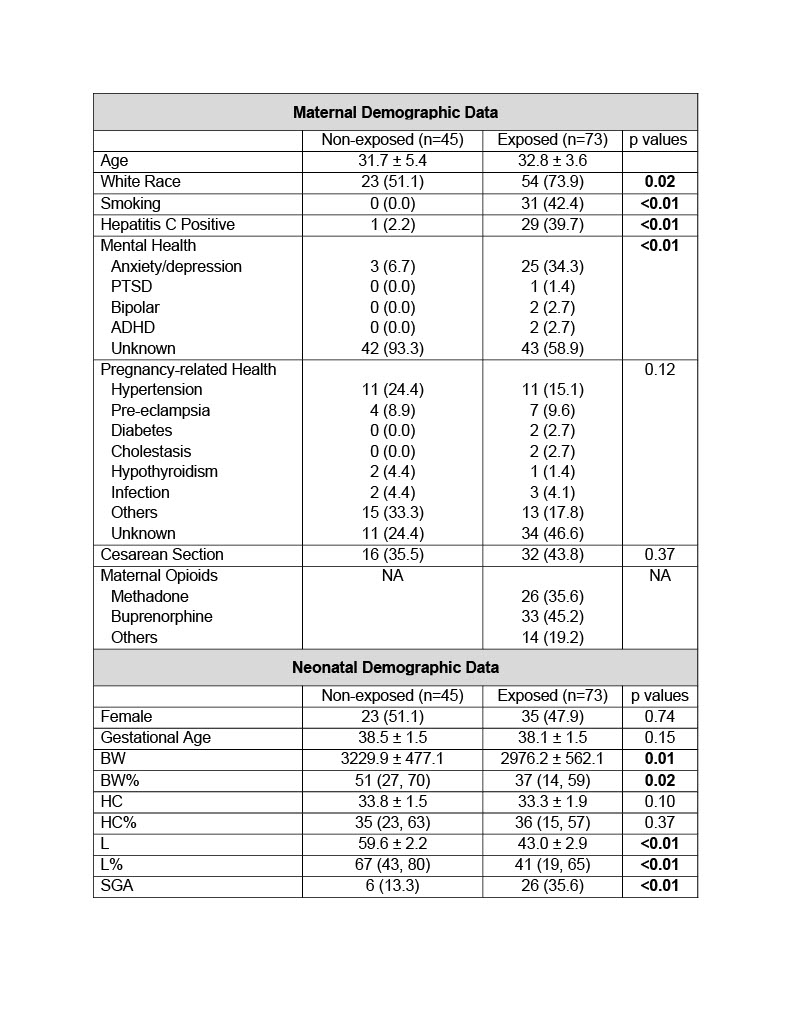Neonatal Fetal Nutrition & Metabolism 3
Session: Neonatal Fetal Nutrition & Metabolism 3
630 - The Effects of Opioid Use on Maternal and Neonatal Body Mass Index: A Pilot Study
Monday, April 28, 2025
7:00am - 9:15am HST
Publication Number: 630.6907
Grace Zhang, Cornell University, Lexington, MA, United States; Kiran Singh, Tufts Medical Center, Boston, MA, United States; Marissa Chow, Tufts Medical Center, Boston, MA, United States; Elizabeth Yen, Tufts University School of Medicine, Boston, MA, United States
.jpg)
Elizabeth Yen, MD
Associate Professor of Pediatrics
Tufts University School of Medicine
Boston, Massachusetts, United States
Presenting Author(s)
Background: Compared to healthy infants, opioid-exposed infants are often born smaller and are either underweight or overweight in the first year of life. The aberrant growth trajectory in infancy may stem from the impact of opioid use on maternal nutrition, but this is not well studied.
Objective: To study the effects of opioid use on the body mass index (BMI) of mother-infant dyads
Design/Methods: This retrospective chart review included mother-infant dyads with and without maternal opioid use. Infants born between 34 and 42 weeks of gestational age were included. Maternal data include pre- and pregnancy BMI, mode of delivery, physical and mental health conditions, race and ethnicity, smoking, and hepatitis C status. Infant data included sex and anthropometric measurements (birth weight, length, head circumference, percentile, and BMI). Statistical analyses were conducted using a two-tailed t-test or Mann-Whitney U test for continuous data, a Chi-squared test for categorical data, and a Pearson test for correlation. Significance is set at p< 0.05.
Results: We included 118 mother-infant dyads (73 in the opioid-use cohort and 45 in the non-use cohort). There is a significantly greater incidence of white race, smoking, hepatitis C, and mental health conditions in mothers with than without opioid use disorder (OUD) (Table). The pre-pregnancy and pregnancy BMI did not differ significantly between mothers without and with OUD (pre: 27.3 vs 25.8 kg/m2, p=0.42, preg: 31.2 vs. 29.4 kg/m2, p=0.15). However, the median of pre- and pregnancy BMI change (ΔBMI) was significantly lower for mothers with OUD (4.9 vs 2.8 kg/m2, p=0.02) (Figure A). Within the exposed cohort, maternal pregnancy BMI correlated significantly with neonatal BMI (r=0.25, p=0.046). Babies exposed to opioids were born significantly smaller at birth (Table). Opioid-exposed infants had a trend of faster BMI gain than their nonexposed peers in the first two years of life (p>0.05) (Figure B).
Conclusion(s): Opioid use is associated with aberrant pregnancy BMI, ranging from low to excessive BMI changes. Maternal nutrition status may affect nutrition support to the fetus and infant’s BMI at birth. While insignificant, the greater BMI change in the first two years in opioid-exposed infants may predispose them to obesity and metabolic syndrome in adulthood. Our preliminary data suggest opioid use adversely affects both maternal and infant nutrition status and highlight the importance of robust nutritional counseling and weight monitoring during pregnancy in mothers with OUD. This study will be validated using a larger sample size.
Table. Demographic Data
 PTSD=post-traumatic stress disorder, ADHD=attention deficit hyperactivity disorder; BW=birth weight, HC=head circumference, L=length, SGA=small for gestational age. Data are presented as mean (standard deviation) for normally distributed continuous measures, median (interquartile ranges) for non-normally distributed continuous measures, or N (%) for categorical measures. Bolded p values represent significance (p < 0.05).
PTSD=post-traumatic stress disorder, ADHD=attention deficit hyperactivity disorder; BW=birth weight, HC=head circumference, L=length, SGA=small for gestational age. Data are presented as mean (standard deviation) for normally distributed continuous measures, median (interquartile ranges) for non-normally distributed continuous measures, or N (%) for categorical measures. Bolded p values represent significance (p < 0.05).Figure. Opioid Use Affects Maternal Nutrition Status and Infant Growth.
 A) Mothers with OUD had a significantly lower and wider range of pregnancy-related BMI change (Δ BMI) than those without OUD (p=0.02); B) Opioid-exposed had a non-significantly faster BMI gain than their nonexposed peers each year from birth to two years. OUD=opioid use disorder, BMI=body mass index, Δ=delta BMI (difference between pregnancy and pre-pregnancy BMI).
A) Mothers with OUD had a significantly lower and wider range of pregnancy-related BMI change (Δ BMI) than those without OUD (p=0.02); B) Opioid-exposed had a non-significantly faster BMI gain than their nonexposed peers each year from birth to two years. OUD=opioid use disorder, BMI=body mass index, Δ=delta BMI (difference between pregnancy and pre-pregnancy BMI).
